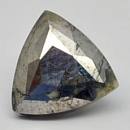|
ClassicGems.net |
|
|
 |
| Ullmannite |
|
|
Discovered in 1843; IMA status: Valid (pre-IMA; Grandfathered) |
|
|
|
Chemistry |
|
|
| |
|
NiSbS | |
|
|
Nickel Antimony Sulfide |
|
Molecular Weight: |
212.51 gm |
|
Composition: |
Nickel |
27.62 % |
Ni |
|
|
|
|
Antimony |
57.29 % |
Sb |
|
|
|
|
Sulfur |
15.09 % |
S |
|
|
|
|
|
100.00 % |
|
|
|
|
|
|
||||
|
Classification |
|
|
| |
|
Sulfides and Sulfosalts | |
|
2/D.18-40 | |
|
|
2 : SULFIDES and SULFOSALTS (sulfides, selenides,
tellurides; arsenides, antimonides, bismuthides; sulfarsenites,
sulfantimonites, sulfbismuthites, etc.) |
|
Related to: |
Cobaltite Group. Ullmannite-Willyamite Series. |
|
Members of Group: |
Cobaltite Group: Changchengite, Cobaltite, Gersdorffite, Hollingworthite, Irarsite, Jolliffeite, Kalungaite, Maslovite, Mayingite, Michenerite, Milotaite, Padmaite, Platarsite, Testibiopalladite, Tolovkite, Ullmannite, Willyamite |
|
Varieties: |
None |
|
Synonyms: |
Antimonikel (of Beudant), Antimon-nickel (of Beudant), Hartmannite, Nickelspiesglaserz, Nickel-stibine |
|
|
|
|
Crystal Data |
|
|
|
|
|
As cubes and, less commonly, octahedra, pyritohedra, tetrahedra, to 3 cm. Cube faces striated by [110], twin boundaries of enantiomorphs. |
|
|
Forms penetration twins about [110] with {001} the approximate composition plane; re-entrants develop on cube edges. |
|
|
|
|
|
Physical Properties |
|
|
|
|
|
Perfect on {001} |
|
|
Irregular/Uneven |
|
|
Brittle |
|
|
5.0 - 5.5; Vickers: VHN100=592-627 kg/mm2 |
|
|
6.65 - 6.85 (g/cm3) |
|
|
None |
|
|
Not Radioactive |
|
|
|
|
|
Optical Properties |
|
|
|
|
|
Steel-gray to silver-white; white in reflected light |
|
|
Opaque |
|
|
Metallic |
|
|
R: (400) 52.0, (420) 51.0, (440) 50.0, (460) 49.0, (480) 48.2, (500) 47.4, (520) 46.7, (540) 46.1, (560) 45.7, (580) 45.5, (600) 45.5, (620) 45.6, (640) 46.0, (660) 46.4, (680) 47.0, (700) 47.6 |
|
|
0.000 (opaque) |
|
|
None |
|
|
None |
|
|
Individuals may be weakly anisotropic revealing a fine lamellar structure. |
|
|
|
|
|
Occurances |
|
|
|
|
|
Geological Setting: |
With nickel minerals in hydrothermal veins. |
|
Common Associations: |
Nickeline, Gersdorffite, Pentlandite, Chalcopyrite, Pyrrhotite, Galena, Tetrahedrite, Dyscrasite |
|
Common Impurities: |
Fe, Co, As, Bi |
|
Type Locality: |
Storch und Schöneberg Mine, Gosenbach, Siegerland, North Rhine-Westphalia, Germany |
|
Year Discovered: |
1843 |
|
View mineral photos: | |
|
|
|
|
Unusual Gem Categories |
|
|
|
|
|
| |
|
|
|
|
More Information |
|
|
|
|
|
| |
|
|
|
|
Ullmannite is a rare nickel antimony sulfide mineral and a member of the Cobaltite Group of minerals that also includes Cobaltite and Gersdorffite among others. Ullmannite has a steel-gray to silver-white color and metallic luster with a Mohs hardness of 5.0 - 5.5. It is very similar to the nickel arsenic sulfide called Gersdorffite. Gersdorffite's formula is NiAsS compared to Ullmannite's formula of NiSbS. Gersdorffite's formula shows the substitution of arsenic (As) for the antimony (Sb) in Ullmannite's formula, although Ullmannite usually has some arsenic in its chemistry. Ullmannite is rarer than Gersdorffite but the two minerals are almost indistinguishable from each other by ordinary evaluation means. Ullmannite was named after Johann Christoph Ullmann (1771-1821), German mineralogist and chemist. Ullmann is considered to be one of the fathers of systematic mineralogy. Ullmann established a mineral collection (now the basis for the internationally renowned Museum of Mineralogy in Marburg) and authored Ein Systematisch Tabellarische Übersicht der Mineralogisch einfachen Fossilien, one of the first attempts to provide a structured organization to the observed minerals of the day. Ullmannite distribution: in Germany, in North Rhine-Westphalia, from Freusburg at the Friedrich mine, near Wissen; the Petersbach mine, near Eichelhardt; Gosenbach; Salchendorf; and at Ramsbeck; in the Harz Mountains, from Neudorf; and elsewhere From Lölling, Carinthia, Austria. In France, at Ar, near Eaux-Bonnes, Pyrénées-Atlantiques. From Monte Narba and Masaloni, Sarrabus, Sardinia, Italy. In the Settlingstones mine, Fourstones, Northumberland, and at New Brancepeth colliery, Durham, England. From the Talnakh area, Noril’sk region, western Siberia, Russia. In the Esperanza mine, Salta Province, Argentina. In Canada, at the Kerr Addison mine, Timiskaming district, Ontario; and from the Nicholson mine, near Goldfields, Saskatchewan. At Broken Hill, New South Wales, Australia. In the Champion Reef mine, Kolar Gold Fields, Karnataka, India. Dozens of additional minor localities are known. |
|
|
Ullmannite gems for sale: We have not photographed our Ullmannite gems yet. Please check back soon. |